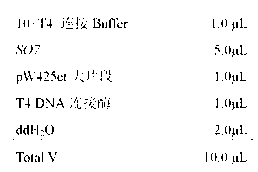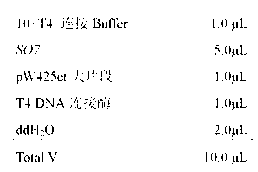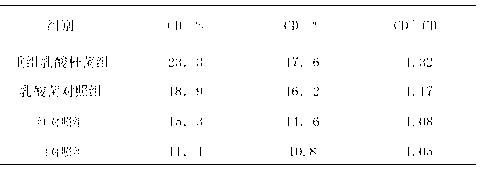Immunological regulation type chicken E.tenella resistant recombinant lactobacillus and preparation method thereof
A technology of immune regulation and lactic acid bacteria, applied in the biological field, can solve problems such as limited production, poor control of immune procedures and methods of use, rejuvenation of coccidia, etc., and achieves simple preparation methods and production processes, and is convenient for large-scale production and application. The effect of broad application prospects
- Summary
- Abstract
- Description
- Claims
- Application Information
AI Technical Summary
Problems solved by technology
Method used
Image
Examples
Embodiment 1
[0026] Example 1 SO7 Gene acquisition
[0027] (1) Design and synthesis of primers
[0028] According to Eimeria tenella published in GenBank SO7 Gene sequence (GI: 9324) uses Primer5.0 software to design primers, and the upstream and downstream primers are designed separately Nco I. Kpn Ⅰ Restriction site, primers were synthesized by Shanghai Sangon Bioengineering Technology Service Co., Ltd. The primer sequences are as follows:
[0029] SO7 Upstream: 5-AT CCATGG CAGACCTCTTCAGCGG-3
[0030] SO7 Downstream: 5-TA GGTACC TGGCCGTTGTGGTGTTGA-3
[0031] (2) SO7 PCR amplification of genes
[0032] The total RNA of the Eimeria tenella Beijing strain was extracted by the conventional Trizol method, reverse-transcribed into cDNA, and the cDNA was used as a template to amplify the target gene with a size of about 651bp using the above primers, as shown in figure 1 shown. Its base sequence is shown in the sequence table SEQ ID NO.1.
[0033]
[0034]
[0035] PCR ...
Embodiment 2
[0038] Example 2 ChIL-2 Gene acquisition
[0039] Published in Genbank ChIL-2 The gene sequence (GI: 49169784) was used as a template. According to the degeneracy of codons and the preference of codons for proteins expressed by lactic acid bacteria, the codons were optimized and sent to Shanghai Sangon Bioengineering Co., Ltd. for synthesis, and the upstream and downstream were added Kpn I and HindⅢ Restriction site. artificially synthesized ChIL-2 The gene is connected to the pUC19 vector, that is, pUC19- ChIL-2 , using conventional enzyme digestion techniques, the application of restriction enzymes Kpn I and Hind Ⅲ Digestion of pUC19- ChIL-2 , obtained the target gene fragment with a size of 471bp ChIL-2 ,Such as figure 2 shown. Its base sequence is shown in the sequence table SEQ ID NO.2.
Embodiment 3
[0040] Example 3 SO7 Gene Linkage to pW425et
[0041] restriction endonuclease Nco I. Kpn Ⅰ Digest pMD18T- SO7 and pW425et, DNA Gel Extraction Kit Recovery SO7 After the gene fragment and the pW425et vector fragment, T4DNA ligase was used for ligation. pW425et, also known as pMG425et, is a vector that inserts the thyA gene (see Chinese patent CN1482247) into the vector pMG36e, uses thyA gene and erythromycin gene as selection pressure, and can shuttle and express between lactic acid bacteria and Escherichia coli.
[0042] Connection system:
[0043]
[0044] Reaction conditions: overnight connection at 16°C; routine CaCl the next day 2 law conversion E. coli DH5α competent, and screen for recombinant positive bacteria.
[0045] Extract recombinant positive bacteria plasmid, using Nco I. Kpn Ⅰ Carry out double enzyme digestion identification, such as image 3 As shown, the target bands with a size of about 4800bp and 651bp were cut out respectively, indicatin...
PUM
 Login to View More
Login to View More Abstract
Description
Claims
Application Information
 Login to View More
Login to View More - R&D
- Intellectual Property
- Life Sciences
- Materials
- Tech Scout
- Unparalleled Data Quality
- Higher Quality Content
- 60% Fewer Hallucinations
Browse by: Latest US Patents, China's latest patents, Technical Efficacy Thesaurus, Application Domain, Technology Topic, Popular Technical Reports.
© 2025 PatSnap. All rights reserved.Legal|Privacy policy|Modern Slavery Act Transparency Statement|Sitemap|About US| Contact US: help@patsnap.com



